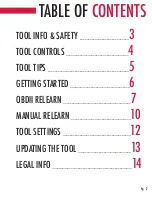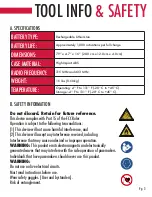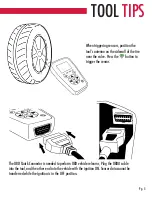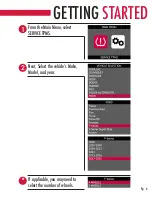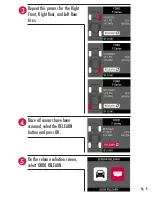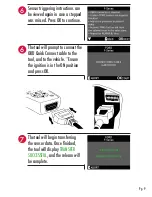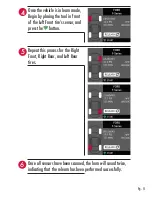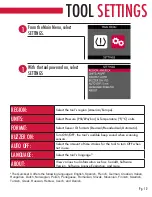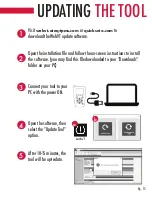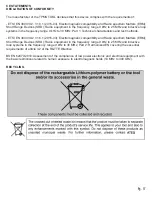
Pg. 16
Safety instructions for Li-Po battery use
The VT56 must be placed on a non-flammable surface during charging (ceramic tray or metal box).
Only charge the Li-Po battery WITH the specific charger provided.
If the battery begins to overheat more than 60°C (140°F), STOP CHARGING IMMEDIATELY. The battery
must NEVER exceed 60°C (140°F) during the charging process.
NEVER charge a battery pack immediately after use and while it is still hot. Let it cool down to room tem-
perature.
If you see any smoke or liquid coming out of the battery, stop charging immediately. Disconnect the bat-
tery from the charger and place the battery in an isolated area for at least 15 minutes. STOP USING THE
BATTERY, and return the device to your dealer.
Always keep a fire extinguisher for electrical fires within reach while charging the battery. In the unlikely
event that the Li-Po battery catches fire, DO NOT use water to extinguish the fire, use sand or the extin-
guisher described above.
The parts of a Li-Po battery must be neutralized out of use. The neutralization procedure must be carried
out within very strict safety parameters. You are recommended to contact a specialist in this battery
type to carry out this process. They will have the out-of-use battery collected by a specialized recycling
organization. Alternatively, contact your dealer.
Do not dispose of Li-Po batteries with household waste.
To avoid leaks or other hazards, do not store batteries above 60°C. Never leave the battery inside a car
(for example) where the temperature could be very high or in a place where the temperature might exceed
60°C. Store the battery in a dry place to avoid contact with any type of liquid. Store the battery only on a
non-flammable surface that is heat resistant and non-conductive, and away from any flammable materials
or sources.
A Li-Po battery must be stored with a minimum charge of 30%. If you store the battery completely dis-
charged, it will quickly become unusable. If it has to be stored for a long period (over 6 months), remem-
ber to recharge it regularly (to more than 30%).
If you do not follow these safety instructions, you risk causing serious damage to people or property, and
you even risk causing a fire!
ATEQ accepts no responsibility in the event of damage arising as a result of non-compliance with these
safety instructions.
Since use of a Li-Po battery entails significant fire risks capable of causing serious damage to people and
property, the user agrees to accept the risks and the responsibility involved.
Since ATEQ cannot control correct use of the battery (charging, discharging, storage, etc.), it cannot be
held responsible for damage caused to people or property.
FCC STATEMENTS
Federal Communication Commission Interference Statement This equipment has been tested and found
to comply with the limits for a Class B digital device, pursuant to Part 15 of the FCC Rules. These limits
are designed to provide reasonable protection against harmful interference in a residential installation.
This equipment generates, uses and can radiate radio frequency energy and, if not installed and used
in accordance with the instructions, may cause harmful interference to radio communications. However,
there is no guarantee that interference will not occur in a particular installation. If this equipment does
cause harmful interference to radio or television reception, which can be determined by turning the
equipment off and on, the user is encouraged to try to correct the interference by one of the following
measures: - Reorient or relocate the receiving antenna. - Increase the separation between the equipment
and receiver. - Connect the equipment into an outlet on a circuit different from that to which the receiver
is connected. - Consult the dealer or an experienced radio/TV technician for help. FCC Caution: Any
changes or modifications not expressly approved by the party responsible for compliance could void the
user’s authority to operate this equipment. This device complies with Part 15 of the FCC Rules. Operation
is subject to the following two conditions: (1) This device may not cause harmful interference, and (2) this
device must accept any interference, including interference that may cause undesired operation.
Summary of Contents for Quickset X
Page 1: ...Q u i c k s e t X USER MANUAL...
Page 18: ...Q u i c k s e t X...

